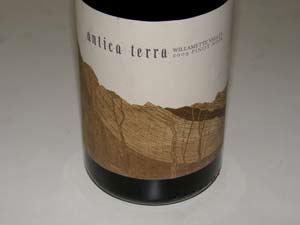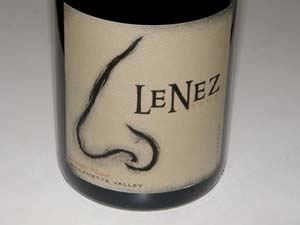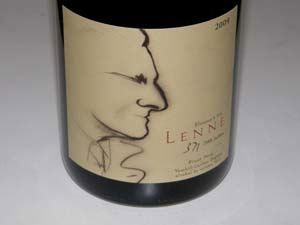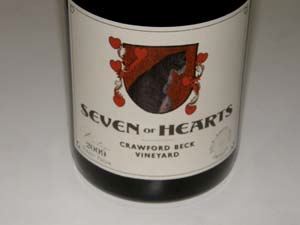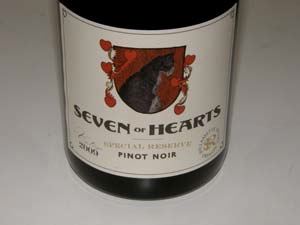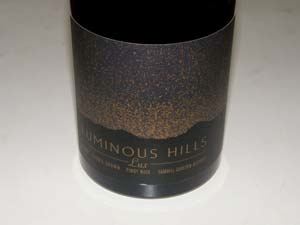Oregon '09: Precocious and Seductive
The 2009 Oregon Pinot Noirs might not be as appealing as the 2008 Oregon Pinot Noirs for the hard-core
pinotphile, but they have found many fans among consumers. It is an early drinking vintage that will not have
the aging potential of the 2008 vintage. An ideal spring led to a large fruit set but the summer was hot and in
conjunction with early September rains, brought mold to some vineyards. Warm temperatures in September
and October led some growers to pick late and the wines, although exuberant, showy and luscious (think
Caliesque), ended up high in alcohol. The vintage was reminiscent of 2006 for some producers. One will need
to tread carefully if your tastes run to more classical Oregon Pinot Noir, choosing those producers who picked
earlier and cropped properly.
Antica Terra
The Antica Terra (“Old Earth” in Latin) vineyard, first planted in 1989, was purchased in 2005 by three friends
and partners along with winemaker Maggie Harrison, a long time former assistant winemaker to Manfred
Krankl at Sine Qua Non in Ventura, California. The 26-acre estate vineyard is situation in the Eola-Amity Hills
appellation. The inaugural Willamette Valley release under Harrison was the 2006 vintage and the wines have
been outstanding from the inaugural vintage. The vineyard had to be upgraded and additional plantings put in
place, so about 50% of the grapes were sourced from other vineyards initially. For 2009, the following wines
were scheduled for release in 2011: Willamette Valley Chardonnay and Estate Grown Pinot Noir (November 1,
2011), Erratica Rosé, Willamette Valley Pinot Noir, and the limited release Botanica (includes fruit from Shea
Vineyard), the latter three April 1, 2011. The wines are sold through a mailing list with some distribution
through retail channels. A new winery was completed in time for the 2009 harvest in Dundee. Vineyard tours
and tasting are available by appointment (503-244-1748). The website is www.anticaterra.com.
2009 Antica Terra Willamette Valley Pinot Noir
13.5% alc., $50. A blend of
estate fruit with grapes from Shea, Old School, Cherry Grove, Johan and Bliss
vineyards. Aged in 50% new French oak barrels.
·
Moderate reddish-purple color
in the glass. Black cherry based aromas and flavors lashed with a noticeable
oak presence of char, tobacco and coffee, but offering nuances of earth and
grilled mushrooms. Creamy and silky, with firm but supple tannins, and a
pleasing aromatic finish. Better the next day from a previously opened and re-corked
bottle. Will benefit from time in the cellar. Good (+).
Lenné Estate
See description under first feature in this issue. Owner Steve Lutz says the 2009 vintage wines should be
consumed within 4 to 5 years. The 2009 wines have higher alcohols, less intensity of flavor, and are more
forward than their 2008 brethren. That said, these are very nice wines to drink while you wait for the 2008s to
mature. The higher alcohols do not intrude unless the wines are allowed to warm to room temperature.
2009 Lenné Estate Le Nez Willamette Valley Pinot Noir
14.8% alc., $30.
Entirely estate fruit with same yields as Lenné Estate Pinot Noir. All five clones
planted at Lenné.
·
Moderately light reddish-purple color in the glass. Aromas of
spiced dark red berries and cherries with a slight roasted character and a hint of
old book. Discreetly concentrated core of dark red berries with underpinnings of
anise and Asian 5-spice. Welcoming elegance, ending with a trace of heat.
Good.
2009 Lenné Estate Yamhill-Carlton District Pinot Noir
14.8% alc., $45. A
selection of best barrels and primarily clones 115 and Pommard.
·
Moderately
light reddish-purple color in the glass. Highly aromatic with notes of dark red
cherries and raspberries, baking spices and sandalwood. Crisp and juicy
flavors which mimic the aromas. Not the intensity of the 2008 vintage, but
more approachable and currently very satisfying. Nicely crafted.
Very Good (+).
2009 Lenné Estate Kill Hill Yamhill-Carlton District Pinot Noir
15.4% alc., 49 cases, $55. From the most
stressed portion of the vineyard with shallow, nutrient poor soil. Clone 667.
·
Moderately light reddish-purple
color in the glass. Subdued nose with reticent aromas of dark red fruits, mushrooms and wet earth. Well-endowed
and noticeably rich with flavors of dark strawberries, dark raspberries, and a kick of citrus on the
finish. Smoothly textured with firm but supple tannins. A ripe, big gulp of Pinot in a Caliesque style. Will have
fans. Good (+).
2009 Lenné Estate Jill’s 115 Yamhill-Carlton District Pinot Noir
14.8% alc., 49 cases, $55.
·
Lightly colored
in the glass. Subdued aromas of crushed red berries and baking spices. Elegantly crafted with charming
flavors of dark red cherries and berries, sassafras and a slight candied, even cotton candy tone. Soft, supple
tannins make for easy drinking. Very Good (-).
2009 Lenné Estate Eleanor’s Vineyard Yamhill-Carlton District Pinot Noir
15.4% alc., 49 cases, $55. First bottling of 114 clone.
·
Moderately light reddish-purple
color in the glass. Enjoyable perfume of delicate red fruits. Red-fruited
with hints of savory oak, spice and dark chocolate, with an appealing velvety
mouth feel. Elegantly styled and easily approachable. Leaves a little heat in its
wake on the finish. Good (+).
Luminous & Seven of Hearts
These wines are the work of Byron Dooley, who, along with his spouse Dana, escaped from Silicon Valley
during the internet bubble of 2000. Arriving in Napa Valley, Byron earned his viticulture and winemaking
degree at Napa Valley College. After an internship at Williams Selyem, he made his own Bordeaux-styled wine
from Napa fruit. In 2004, the couple acquired a property in the Yamhill-Carlton District and developed a 11.2-
acre estate vineyard named Luminous Hills. Two labels were started: Seven of Hearts and Luminous Hills.
Dana opened Honest Chocolates in McMinnville selling traditional style chocolates. Later, a second branch
was opened in Carlton which shares space with the Seven of Hearts and Luminous Hills Tasting Room.
Seven of Hearts is about exploring vineyards in Oregon’s Willamette Valley and neighboring regions, featuring
distinct appellations and in some cases, unique vineyards, as well as other varieties along with Pinot Noir. The
label’s neoclassical elements symbolizes the winery’s passion for the traditional Burgundian style of Pinot Noir.
Wines from the estate vineyard are vinified under the Luminous Hills label. The vineyard is a unique high
elevation site with both sedimentary and volcanic soils. The planted clones are Dijon 115, 667 and 777, and
Pommard. The vineyard is dry-farmed and a participant in the L.I.V.E. sustainability program. Three wines are
produced from the Luminous Hills Vineyard: a Yamhill-Carlton District Estate Grown Pinot Noir, the LUX Pinot
Noir (777 and Pommard selection) and the ASTRA Pinot Noir (100% whole cluster 667, 60% 667 and 777
partially whole cluster fermented in a supporting role). Luminous Hills is unique for the two delineated soil types
and diversity of terrain. The vineyard is divided into distinct blocks based on elevation, soil type and clones
planted. The goal is to create distinct wines that highlight the differences in the different blocks of the vineyard.
The Estate Grown bottling uses a broad selection from the vineyard. LUX is a smaller production wine largely
based on Pommard grown on sedimentary soil. Whole cluster is about 50% in this wine, largely from one of
the lots of Pommard that was 100% whole cluster fermented in combination with some partially whole cluster
fermented 777. The ASTRA, which was launched in the 2009 vintage, is marked by the high percentage of 667
that is whole cluster fermented. Byron calls the LUX more voluptuous, ASTRA more radiant. The layout of the
Luminous Hills Vineyard blocks is depicted below:
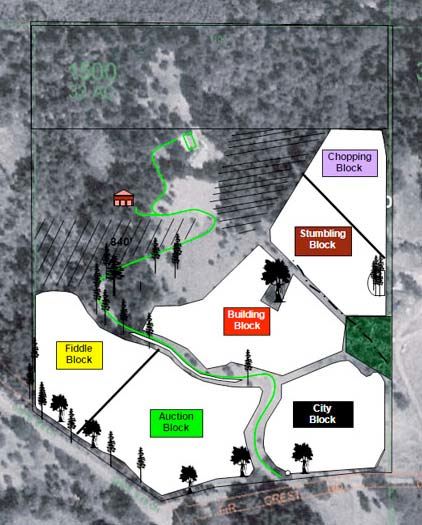
The winemaking approach for Seven of Hearts and Luminous Hills is the same using traditional methods such
as native yeast fermentation, whole cluster fermentation when appropriate, minimal handling and additions,
and largely no fining or filtering.
Varietals that are classically grown in France are featured under the Chatte d’Avignon sub-label of Seven of
Hearts. Seven of Hearts wines (www.sevenofheartswine) and Luminous Hills wines (www.luminoushills.com)
are sold on the respective websites. The owners sum up their goal as follows: “We want to make accessible
(meaning both affordable and approachable) wines that are genuine expressions of different varietals, where
they are from, and the conditions under which they were grown; wines with complexity, purity and elegance.”
2009 Seven of Hearts Willamette Valley Pinot Noir
13.8% alc., 630 cases, $20. Released February 1, 2011
via tap program in Portland restaurants, May 1, 2011 in bottles. Sourced from five vineyards in three
appellations. Pommard, Wädenswil, 777, 667 and 115 clones. 12% whole cluster, native yeast fermentation,
23% new French oak barrels, unfined and unfiltered.
·
Moderately light reddish-purple color in the glass. Hint of
volatile acidity which lessens over time. Scent of spiced red berries and a hint of new oak. Flavors of red
strawberries and cranberries and cherries with savory herbs. Bright acidity and mild tannins. A daily drinker.
Decent.
2009 Seven of Hearts Crawford Beck Vineyard Eola-Amity Hills Pinot Noir
14.5% alc., 98 cases, $35.Released May 1, 2011. 100% clone 115 from a single
vineyard with volcanic soils. Native yeast fermentation, aged in 23% new
French oak barrels, unfined and unfiltered.
·
Moderate reddish-purple color in the
glass. Aromas of dark red fruits including strawberries, polished wood and cut
flowers. Tasty essence of darker red berries and cherries with a subtle note of
anise and a riff of citrus peel on the finish. Soft in the mouth with supple tannins
and bright acidity at the end. Good.
2009 Seven of Hearts Special Reserve Willamette Valley Pinot Noir
14.0%
alc., 147 cases, $42. Released May 1, 2011. From four vineyards in three
appellations (including Luminous Hills) and both volcanic and sedimentary
soils. Clones 114, 115, 667, 777, Pommard and Wädenswil. 33% whole
cluster fermentation, native yeast fermentation, aged in 23% new French oak
barrels, unfined and unfiltered.
·
Moderately light reddish-purple color in the
glass. Nice array of aromas including fresh cherries, red currants, spice and a
hint of vanilla. Cherry pie filling is the theme with crisp acidity, firm tannins and
a lingering presence of perfectly ripe fruit on the finish. Very ephemeral in the
mouth. Very Good.

2009 Luminous Hills Estate Grown Yamhill-Carlton District Pinot Noir
15.0% alc., 357 cases,
$28. Released February 24, 2011. Clones 667 from higher elevation volcanic Jory soils on the site
and 115 and Pommard clones from the lower elevation sedimentary sites. 20% whole cluster
fermentation (including 100% whole cluster Pommard), native yeast fermentation, aged in 23% new
French oak barrels, unfined and unfiltered.
·
Moderately light reddish-purple color in the glass.
Aromas of summer red fruits with hints of cedar and rose bouquet. Light on its feet, with tasty red
berry and cherry flavors, complimentary oak highlights, and an aromatically floral finish. A discreetly
composed and charming wine. Very Good.

2009 Luminous Hills Estate Grown Yamhill-Carlton District ASTRA Pinot Noir
15.0% alc., 98 cases, $35. Released May
1, 2011. Released February 24,, 2011. 60% clone 667 from
higher elevation volcanic soils and 40% 115 from lower
elevation sedimentary soils. 60% whole cluster, native yeast
fermentation, aged in 23% new French oak barrels, unfined
and unfiltered.
·
Moderately light reddish purple hue in the
glass. Very shy nose with demure aromas of red stone fruits and spice. A
carnival of charming black cherry and black raspberry fruit floods the palate and
brings it to attention. This is one of those wines that you taste and then just look
at the glass, astonished that such flavor could originate from the liquid in the glass. Clean and polished with an
ephemeral presence, ending with a generously fruity finish that leaves a touch of heat in its wake.

2009 Luminous Hills Estate Grown Yamhill-Carlton District LUX Pinot Noir
15.0% alc., 147cases, $35. Released February 24,
2011. Primarily Pommard clone from the lower elevation
sedimentary soils (66%) with 777 from the higher elevation volcanic
soils in a supporting role (33%). 50% whole cluster fermentation,
aged in 23% new French oak barrels, unfined and unfiltered.
·
Moderately light reddish-purple color in the glass. Flamboyant
aromas of fresh red berries with Asian 5-spice. Well-endowed flavors of dark
red cherries and berries with a firm tannic backbone. Similar to the ASTRA but
more darkly fruited. Impressive persistence on the memorable finish. Despite
the high alcohol, the fruit is neither over ripe or roasted in character. Very Good (+).
|
|
|



